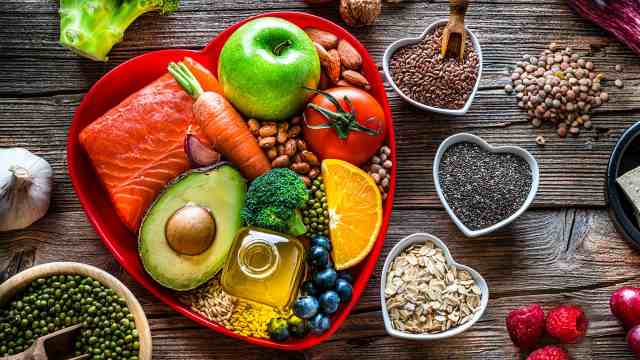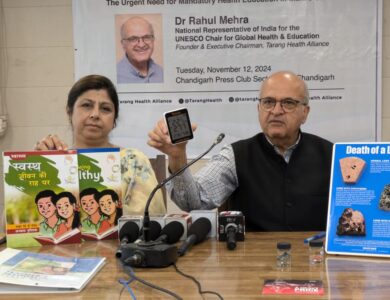Suffering from High Blood Pressure? You Should Try DASH Diet

The DASH diet, short for Dietary Approaches to Stop Hypertension, stands out as a meticulously crafted dietary plan aimed at not only preventing but effectively managing hypertension or high blood pressure. Devised by the National Heart, Lung, and Blood Institute (NHLBI), this health-focused regimen places a premium on fostering a balanced and heart-healthy approach to eating, transcending mere restriction to usher in a lifestyle centered on holistic well-being.
Delving into the intricate details of the DASH diet reveals a multifaceted approach, strategically integrating a variety of food groups to optimize health benefits. Let’s embark on a deeper exploration of its key features:
- Abundant Fruits and Vegetables: The DASH diet encourages not just the consumption but the celebration of a diverse array of fruits and vegetables. Beyond the mere aesthetic appeal of their vibrant colors, these plant-based powerhouses offer a rich tapestry of essential vitamins, minerals, and antioxidants. The inclusion of such nutrient-dense options becomes a cornerstone for supporting overall health and fortifying the body against various ailments.
- Whole Grains as Pillars of Nutrition: Central to the DASH philosophy is the emphasis on whole grains, elevating staples like brown rice, quinoa, and whole wheat to nutritional pedestals. The inherent richness in fiber and essential nutrients complements the dietary strategy, contributing not only to cardiovascular health but also fostering a sustained release of energy and promoting digestive well-being.
- Lean Proteins for Optimal Health: In the realm of proteins, the DASH diet takes a nuanced stance, recommending lean sources such as poultry, fish, nuts, and legumes. This strategic approach minimizes the intake of red meat and processed meats, aligning with broader health guidelines that highlight the advantages of lean protein consumption for heart health and overall vitality.
- Low-Fat Dairy for Essential Nutrients: The inclusion of low-fat or fat-free dairy products becomes pivotal in ensuring a well-rounded intake of calcium and other essential nutrients. This aspect not only supports bone health but also aligns with dietary principles promoting the moderation of saturated fats, contributing to cardiovascular wellness.
- Nuts, Seeds, and Legumes for Holistic Nutrition: The DASH diet urges the incorporation of nuts, seeds, and legumes, recognizing their role as nutritional powerhouses providing healthy fats, protein, and fiber. This diversified inclusion further enriches the dietary landscape, fostering satiety, and contributing to overall cardiovascular well-being.
- Strategic Sodium Reduction: A defining characteristic of the DASH diet lies in its advocacy for limited sodium intake. This deliberate reduction, achieved by minimizing processed foods and steering clear of excessive salt, plays a crucial role in managing blood pressure. By mitigating sodium-related concerns, the diet takes proactive steps toward comprehensive cardiovascular health.
- Moderate Alcohol Consumption Guidelines: The DASH diet adopts a pragmatic stance on alcohol consumption, permitting moderation while providing clear guidelines on limits. This nuanced approach aligns with broader health recommendations, allowing for a balanced lifestyle that supports heart health without imposing rigid restrictions.
- Mindful Portion Control: At the heart of the DASH philosophy lies the principle of mindful eating and portion control. This deliberate focus extends beyond specific food choices, aiming to manage overall calorie intake. By fostering an awareness of portion sizes, the diet empowers individuals to make conscious and health-centric choices, contributing to sustainable weight management.
- Curbing Sweets and Added Sugars: The DASH diet recognizes the impact of added sugars on overall health and weight management. By advocating for reduced consumption of sweets and added sugars, it aligns with contemporary dietary principles that prioritize whole, unprocessed foods for long-term well-being.
As a testament to its efficacy, the DASH diet has garnered recognition for its ability to significantly reduce blood pressure and promote cardiovascular health. Originally designed to address hypertension, its universal appeal has positioned it not only as a therapeutic measure but as a comprehensive healthy eating plan for individuals seeking to enhance their overall well-being.
In essence, the DASH diet transcends the scope of mere dietary restriction, evolving into a lifestyle that seamlessly integrates with broader dietary guidelines emphasizing whole, nutrient-dense foods. Its adaptability and emphasis on holistic health make it not just a response to a specific health concern but a blueprint for sustainable well-being for individuals at various stages of life.
Interesting Facts about DASH Diet
- Scientific Foundation: The DASH (Dietary Approaches to Stop Hypertension) diet was developed and extensively researched by the National Heart, Lung, and Blood Institute (NHLBI) to specifically address and manage hypertension.
- Holistic Approach: Beyond its primary focus on blood pressure reduction, the DASH diet promotes overall heart health and well-being, making it a comprehensive dietary plan for individuals seeking a balanced lifestyle.
- Proven Blood Pressure Reduction: Clinical studies have shown that following the DASH diet can lead to significant reductions in blood pressure, making it an effective non-pharmacological approach to managing hypertension.
- Adaptability: The DASH diet is versatile and can be tailored to individual preferences and dietary needs, accommodating various cultural and personal eating habits.
- Rich in Nutrient-Dense Foods: The emphasis on fruits, vegetables, whole grains, and lean proteins ensures a diet rich in essential vitamins, minerals, and antioxidants, contributing to overall health.
- Inclusion of Healthy Fats: Contrary to some misconceptions about low-fat diets, the DASH diet incorporates healthy fats from sources like nuts and seeds, promoting cardiovascular health.
- Reduced Sodium Intake: The DASH diet advocates for limiting sodium intake, a crucial factor in managing blood pressure. It encourages the reduction of processed foods and emphasizes the use of herbs and spices for flavor.
- Suitable for Weight Management: While not primarily a weight-loss diet, the DASH approach supports weight management through its focus on portion control, whole foods, and reduced consumption of sweets and added sugars.
- Moderate Alcohol Guidelines: The DASH diet allows for moderate alcohol consumption, providing clear guidelines on limits. This balanced approach aligns with broader health recommendations.
- Positive Impact on Cholesterol Levels: In addition to its blood pressure benefits, the DASH diet has been shown to positively influence cholesterol levels, contributing to a more comprehensive cardiovascular health profile.
The DASH diet’s combination of evidence-based health benefits, adaptability, and focus on whole, nutrient-dense foods makes it an intriguing and widely recommended dietary approach for those aiming to enhance their cardiovascular well-being.
Frequently Asked Questions (FAQ) About the DASH Diet
1. What is the DASH diet?
- The DASH (Dietary Approaches to Stop Hypertension) diet is a dietary plan developed by the National Heart, Lung, and Blood Institute (NHLBI) to prevent and manage hypertension (high blood pressure).
2. What are the key features of the DASH diet?
- The DASH diet emphasizes high intake of fruits and vegetables, whole grains, lean proteins, low-fat dairy, nuts, seeds, legumes, limited sodium intake, moderate alcohol consumption, portion control, and reduced sweets and added sugars.
3. Is the DASH diet only for individuals with hypertension?
- While initially designed for hypertension, the DASH diet is recognized for promoting overall heart health and is recommended for anyone seeking a balanced and nutritious eating plan.
4. Can the DASH diet be personalized to individual preferences?
- Yes, the DASH diet is adaptable and can be tailored to accommodate various dietary preferences, cultural considerations, and individual needs.
5. Is the DASH diet effective for reducing blood pressure?
- Clinical studies have demonstrated that following the DASH diet can lead to significant reductions in blood pressure, making it an effective non-pharmacological approach for managing hypertension.
6. Does the DASH diet support weight loss?
- While not primarily a weight-loss diet, the DASH approach encourages portion control, consumption of nutrient-dense foods, and limited sweets, contributing to a healthy weight.
7. Can I follow the DASH diet if I have dietary restrictions, such as vegetarianism or gluten intolerance?
- Yes, the DASH diet is flexible and can accommodate various dietary restrictions. It allows for modifications to meet individual needs, making it inclusive for different lifestyles.
8. How does the DASH diet impact cholesterol levels?
- In addition to blood pressure benefits, the DASH diet has been shown to positively influence cholesterol levels, contributing to a more comprehensive cardiovascular health profile.
9. Are there specific guidelines for alcohol consumption in the DASH diet?
- Yes, the DASH diet permits moderate alcohol consumption, with clear guidelines on limits. This balanced approach aligns with broader health recommendations.
10. Can the DASH diet be used for long-term wellness? – Yes, the DASH diet is designed for long-term adoption as a sustainable and health-promoting lifestyle. It aligns with broader dietary guidelines emphasizing whole, nutrient-dense foods for overall well-being.
Here’s a sample six-day DASH diet plan for an individual following an Indian diet:
Day 1:
- Breakfast: Vegetable Poha (flattened rice with vegetables)
- Lunch: Dal (lentil curry), Brown Rice, Mixed Vegetable Sabzi
- Snack: Fresh Fruits
- Dinner: Grilled Chicken or Tofu, Quinoa Salad
Day 2:
- Breakfast: Oats Upma (savory oats with vegetables)
- Lunch: Chickpea Curry (Chana Masala), Roti, Cucumber Raita
- Snack: Nuts and Seeds Mix
- Dinner: Fish Curry, Brown Rice, Stir-fried Broccoli
Day 3:
- Breakfast: Whole Wheat Paratha with Curd
- Lunch: Vegetable Khichdi (rice and lentil dish), Yogurt
- Snack: Sliced Apple with Peanut Butter
- Dinner: Egg Curry, Quinoa Pulao, Mixed Vegetable Salad
Day 4:
- Breakfast: Idli with Coconut Chutney and Sambhar
- Lunch: Spinach and Paneer (Indian cottage cheese) Curry, Roti, Cabbage Salad
- Snack: Greek Yogurt with Berries
- Dinner: Lentil Soup (Dal Tadka), Brown Rice, Stir-fried Okra
Day 5:
- Breakfast: Whole Wheat Toast with Avocado and Tomato
- Lunch: Rajma (Kidney Bean Curry), Quinoa, Mint Chutney
- Snack: Banana with Almond Butter
- Dinner: Grilled Chicken or Tofu, Millet Pilaf, Vegetable Stir-Fry
Day 6:
- Breakfast: Moong Dal Cheela (lentil pancakes) with Mint Chutney
- Lunch: Baingan Bharta (Roasted Eggplant Curry), Roti, Cucumber Raita
- Snack: Mixed Nuts
- Dinner: Fish Curry, Brown Rice, Stir-fried Asparagus
Please note that portion sizes can vary based on individual requirements, and it’s essential to stay hydrated by drinking plenty of water throughout the day. Adjust the plan according to personal preferences and dietary needs, and consider consulting with a healthcare professional or a nutritionist for personalized advice.
Disclaimer: The information provided herein is for general informational purposes only and should not be considered as professional or medical advice. It is not intended to replace consultation with qualified healthcare professionals. The use of any information provided is at your own discretion and risk. While efforts are made to ensure the accuracy and currency of the content, no guarantee is given regarding the accuracy, reliability, or completeness of the information. Any reliance you place on such information is strictly at your own risk. Always seek the advice of your physician or other qualified health providers with any questions you may have regarding a medical condition. Never disregard professional medical advice or delay seeking it because of something you have read herein.








